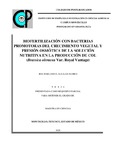Biofertilización con bacterias promotoras de crecimiento vegetal y presión osmótica de la solución nutritiva en la producción de col (Brassica oleracea Var. Royal Vantage).
Abstract
En la presente investigación se evaluó el efecto de la biofertilización y la presión osmótica en el desarrollo y producción de Brassica oleracea Var. Royal vantage en condiciones de invernadero. Se estableció un diseño factorial 4x3, donde los factores fueron cuatro niveles de presión osmótica (0.18, 0.36, 0.54 atm. y sin solución nutritiva), en combinación con inoculación bacteriana AA (Azospirillum brasilense+ Acinetobacter calcoaceticus) y RC (Raoultella terrígena+Chromobacterium violaceum) y un testigo sin inocular. Por cada tratamiento se establecieron 6 repeticiones. Las semillas inoculadas con el consorcio AA presentaron mayor porcentaje de emergencia (100 %) y una tasa de emergencia más alta (20.5), con respecto a la inoculación con el consorcio RC y las plantas no inoculadas. La inoculación con AA y la presión osmótica de 0.54 atm produjeron plantas más altas (60-65 %), y tallos con mayor diámetro (35-46 %). El número de hojas incrementó un 15 y 10 % en las plantas inoculadas con los consorcios AA y RC respectivamente. El peso de la biomasa fresca y la acumulación de la masa seca se duplicaron en las plantas inoculadas con respecto a las no inoculadas. Hubo una mayor concentración de K en plantas inoculadas con AA y RC (20-35 y 25-45 % respectivamente) con respecto a las plantas no inoculadas. La concentración de Nitratos se incrementó entre 200-350 y 60-230 % al inocular con AA y RC respectivamente. La concentración de P se incrementó entre un 200-500 % con el consorcio AA y entre 100-400 % con el consorcio RC. La producción de col incrementó más del 100 % en plantas inoculadas con los consorcios AA y RC, y con una presión osmótica de 0.54 atm en comparación con el control no inoculado. _______________ BIOFERTILIZATION WITH PLANT GROWTH PROMOTING BACTERIA AND NUTRIENT SOLUTION OSMOTIC PRESSURE IN THE PRODUCTION OF COL (Brassica oleracea var. Royal Vantage). ABSTRACT: In the present investigation, the effect of biofertilization and osmotic pressure on the development and production of Brassica oleracea var. Royal vantage in greenhouse conditions were evaluated. A 4x3 factorial design was established, the factors were four levels of osmotic pressure (0.18, 0.36, 0.54 atm and without nutritient solution), in combination with bacterial inoculation AA (Azospirillum brasilense + Acinetobacter calcoaceticus) and RC (Raoultella terrígena + Chromobacterium violaceum) and non-inoculated control. The rate and percentage of emergence, plant height, stem diameter, number of leaves, head production, production of fresh biomass, accumulation of dry mass and concentration of phosphorus, nitrate and potassium in sap were analyzed. Seeds inoculated with the AA consortium had the highest emergence percentage (100%) and a higher emergence rate (20.5), compared with inoculation with the RC consortium and the non-inoculated plants. Inoculation with AA and the osmotic pressure of 0.54 atm. produced taller plants (60-65%), and a stem with a larger diameter (35-46%). The number of leaves increased by 15 and 10% in the plants inoculated with the AA and RC consortia, respectively. The weight of the fresh biomass and the accumulation of the dry mass were doubled in the inoculated plants compared to the non-inoculated ones. There was a higher concentration of K in plants inoculated with AA and RC (20-35 and 25-45% respectively) compared to non-inoculated plants. The nitrate concentration increased between 200-350 and 60-230% when inoculating with AA and RC, respectively. The concentration of P increased between 200-500% with the AA consortium and between 100-400% with RC Cabbage production increased more than 100% in plants inoculated with the AA and RC consortia, with an osmotic pressure of 0.54 atm compared to the non-inoculated control.Cabbage production increased more than 100% in plants inoculated with the AA and RC consortia, with a osmotic pressure of 0.54 atm. compared to the non-inoculated control.
Collections
- Tesis MC, MT, MP y DC [349]


